Evidence of the Environmental Kuznets Curve: Unleashing the Opportunity of Industry 4.0 in Emerging Economies
Abstract
1. Introduction
2. Theoretical Background
2.1. Studies on the Relationship between the Economic Development and Environmental Degradation
2.2. Concept of Industry 4.0 and Sustainability Implications
3. Data and Methodology
- logCO2t—is the logarithm of CO2 emissions;
- logGDPt and log2GDPt—is the logarithm of GDP and its square;
- logFDIt—is the logarithm of FDI net inflows;
- logTradet—is the logarithm of trade in services (the sum of service exports and imports divided by the value of GDP);
- logEnergyt—is the logarithm of energy intensity level of primary energy;
- t—is the sampling year;
- ε—is the vector of the residuals;
- if β2 = β1 = 0, the hypothesis on the relationships between economic growth and environmental degradation can be rejected;
- if β2 = 0 and β1 > 0, there is a linear relationship;
- if β1 > 0 and β2 < 0, there is an inverted U-shaped relationship between economic growth and CO2 emission (in this case, the environmental Kuznets curve hypothesis can be accepted);
- if β1 < 0 and β2 > 0, there is a positive U-shaped relationship;
4. Results
4.1. Regressions on Relationships between Carbon Emission and Economic Development
- H0: μ1 = μ2 = μ3
- H1: at least one of the means is different.
4.2. Income Elasticity of Environmental Degradation
4.3. Energy Intensity of GDP
4.4. Carbon Intensity of GDP
4.5. Level of CO2 Emissions
4.6. Investigation of the Relationship between ICT Use and Energy Consumption
5. Discussion
5.1. Limitations and Recommendations
- −
- energy saving and energy efficiency (attraction of FDI to unleash innovation potential of the industry);
- −
- strategic reserves (harnessing the power of the energy sector, including renewables);
- −
- import diversification (advanced supply chain transparency);
- −
- integration into the EU energy area (connected and synchronized energy networks).
5.2. Implications
6. Conclusions
Funding
Conflicts of Interest
References
- Annen, Kurt. 2006. HP-Filter Excel Add-In. Available online: https://web-reg.de/webreg-hodrick-prescott-filter/ (accessed on 12 May 2019).
- Belkhir, Lotfi, and Ahmed Elmeligi. 2018. Assessing ICT global emissions footprint: Trends to 2040 & recommendations. Journal of Cleaner Production 177: 448–63. [Google Scholar]
- Bertoldi, Paolo, Maria Avgerinou, and Luca Castellazzi. 2017. Trends in Data Centre Energy Consumption under the European Code of Conduct for Data Centre Energy Efficiency. Luxembourg: Publications Office of the European Union. [Google Scholar]
- Blunck, Erskin, and Hedwig Werthmann. 2017. Industry 4.0—An Opportunity to Realize Sustainable Manufacturing and its Potential for a Circular Economy. Microeconomics 3: 645–66. [Google Scholar]
- Bocken, Nancy M. P., Samuel W. Short, Padmakshi Rana, and Steve Evans. 2014. A literature and practice review to develop sustainable business model archetypes. Journal of Cleaner Production 65: 42–56. [Google Scholar] [CrossRef]
- Bonilla, Silvia, Helton Silva, Marcia Terra da Silva, Rodrigo Franco Gonçalves, and José Sacomano. 2018. Industry 4.0 and Sustainability Implications: A Scenario-Based Analysis of the Impacts and Challenges. Sustainability 10: 3740. [Google Scholar] [CrossRef]
- BP Statistical Review of World Energy. 2018. Centre for Energy Economics Research and Policy, Heriot-Watt University (67th ed.). Available online: https://www.bp.com/content/dam/bp/business-sites/en/global/corporate/pdfs/energy-economics/statistical-review/bp-stats-review-2018-full-report.pdf (accessed on 17 May 2019).
- Buzan, Barry, Ole Wæver, Ole Wæver, and Jaap De Wilde. 1998. Security: A New Framework for Analysis. Boulder: Lynne Rienner, p. 239. [Google Scholar]
- Environmental Defense Fund. 2018. Business and the Fourth Wave of Environmentalism. Available online: https://www.edf.org/sites/default/files/documents/business_and_the_fourth_wave.pdf (accessed on 17 May 2019).
- The Environmental Performance Index. 2018. Yale University. Available online: https://epi.envirocenter.yale.edu/ (accessed on 17 May 2019).
- EViews. 2019. Unit Root Testing. Available online: http://www.eviews.com/help/helpintro.html#page/content/advtimeser-Unit_Root_Testing.html (accessed on 17 May 2019).
- Frankel, Jeffrey A., and Andrew K. Rose. 2005. Is Trade Good or Bad for the Environment? Sorting Out the Causality. The Review of Economics and Statistics 87: 85–91. [Google Scholar] [CrossRef]
- Garcia-Muiña, Fernando, Rocío González-Sánchez, Anna Ferrari, and Davide Settembre-Blundo. 2018. The Paradigms of Industry 4.0 and Circular Economy as Enabling Drivers for the Competitiveness of Businesses and Territories: The Case of an Italian Ceramic Tiles Manufacturing Company. Social Sciences 7: 255. [Google Scholar] [CrossRef]
- Gavrilescu, Maria. 2004. Cleaner production as a tool for sustainable development. Environmental Engineering and Management Journal 3: 45–70. [Google Scholar] [CrossRef]
- Grytten, Ola Honningdal, and Viktoriia Koilo. 2019. The Financial Instability Hypothesis and the Financial Crisis in Eastern European Emerging Economies. Available online: https://papers.ssrn.com/sol3/papers.cfm?abstract_id=3381533 (accessed on 11 May 2019).
- Hisamatsu, Hiroyuki, and Koichi Maekawa. 1994. The distribution of the Durbin–Watson statistic in integrated and near-integrated models. Journal of Econometrics 61: 367–82. [Google Scholar] [CrossRef]
- The Division for Sustainable Development Goals (DSDG). 2019. The High-Level Political Forum on Sustainable Development in 2019 (HLPF 2019). Available online: https://sustainabledevelopment.un.org/hlpf/2019/ (accessed on 12 May 2019).
- Holden, Erling, Kristin Linnerud, David Banister, Valeria Jana Schwanitz, and August Wierling. 2017. The Imperatives of Sustainable Development. Sustainable Development 25: 213–26. [Google Scholar] [CrossRef]
- Human Development Index. 2017. United Nations Development Programme. Available online: http://www.hdr.undp.org/en/data (accessed on 17 May 2019).
- International Telecommunication Union. 2017. TU World Telecommunication. ICT Indicators Data. Available online: https://www.itu.int/en/ITU-D/Statistics/Pages/stat/default.aspx (accessed on 22 June 2019).
- Kacar, S. Burak, and M. Ozgur Kayalica. 2014. Environmental Kuznets Curve and sulfur emissions: A comparative econometric analyzis. Environmental Economics 5: 8–20. [Google Scholar]
- Kagermann, Henning, Wolf-Dieter Lukas, and Wolfgang Wahlster. 2011. Industrie 4.0: Mitdem Internet der Dinge auf dem Weg zur 4. Industriellen Revolution. VDI Nachrichten 13. Available online: http://www.wolfgang-wahlster.de/wordpress/wp-content/uploads/Industrie_4_0_Mit_dem_Internet_der_Dinge_auf_dem_Weg_zur_vierten_industriellen_Revolution_2.pdf (accessed on 11 May 2019).
- Kagermann, Henning, Wolfgang Wahlster, and Johannes Helbig. 2013. Secoring the Future of German Manufacturing Industry: Recommendations for Implementing the Strategic Initiative INDUSTRIE 4.0, Final Report of the Industrie 4.0 Working Group. Available online: https://www.din.de/blob/76902/e8cac883f42bf28536e7e8165993f1fd/recommendations-for-implementing-industry-4-0-data.pdf (accessed on 30 June 2019).
- Karpa, Waldemar. 2017. The Effect of Low-Carbon Innovations on Reducing Environmental Threats to Health. Journal of Innovation Economics & Management 24: 89–104. [Google Scholar]
- Kaya, Gizem, Merve Kumaş, and Burc Ulengin. 2017. The role of foreign direct investment and trade on carbon emissions in Turkey. Environmental Economics 8: 8–17. [Google Scholar] [CrossRef]
- Lee, Jay, Hossein Davari, Jaskaran Singh, and Vibhor Pandhare. 2018. Industrial Artificial Intelligence for Industry 4.0-based Manufacturing Systems. Manufacturing Letters 18: 20–23. [Google Scholar] [CrossRef]
- Manoukian, Jean-Grégoire. 2018. Industry 4.0 meets the 4th Wave of Environmentalism. Available online: https://enablon.com/blog/2018/06/28/industry-4-0-meets-the-4th-wave-of-environmentalism (accessed on 12 May 2019).
- Nguyen, Viet-Ha T., Thu-Trang Vuong, Manh-Tung Ho, and Quan-Hoang Vuong. 2019. The new politics of debt in the transition economy of Vietnam Hong-Kong. Austrian Journal of South-East Asian Studies 12: 91–110. [Google Scholar]
- Panayotou, Theodore. 1993. Empirical Tests and Policy Analysis of Environmental Degradation at Different Stages of Economic Development. Geneva: International Labour Organization. [Google Scholar]
- Park, Jacob, Joseph Sarkis, and Zhaohui Wu. 2010. Creating integrated business and environmental value within the context of China’s circular economy and ecological modernization. Journal of Cleaner Production 18: 1494–501. [Google Scholar] [CrossRef]
- Pouri, Maria J., and Lorenz M. Hilty. 2018. Conceptualizing the Digital Sharing Economy in the Context of Sustainability. Sustainability 12: 4453. [Google Scholar] [CrossRef]
- PricewaterhouseCoopers. 2016. Industry 4.0: Building the Digital Enterprise. 2016 Global Industry 4.0 Survey. Available online: https://www.pwc.com/id/en/CIPS/assets/industry-4.0-building-your-digital-enterprise.pdf (accessed on 12 May 2019).
- Shahbaz, Muhammad, and Avik Sinha. 2018. Environmental Kuznets Curve for CO2 Emission: A Literature Survey, MPRA Paper. Available online: https://mpra.ub.uni-muenchen.de/86281/ (accessed on 17 May 2019).
- Stern, David I. 2004. The rise and fall of the environmental Kuznets curve. World Development 32: 1419–39. [Google Scholar] [CrossRef]
- The Global Commission on the Economy and Climate. 2018. Unlocking the Inclusive Growth Story of the 21st Century: Accelerating Climate Action in Urgent Times. Available online: https://newclimateeconomy.report/2018/wp-content/uploads/sites/6/2018/09/NCE_2018_FULL-REPORT.pdf (accessed on 19 May 2019).
- The World Bank. 2019. World Development Indicators. Washington, DC: World Bank. Available online: https://data.worldbank.org/indicator (accessed on 17 May 2019).
- Tjoek, Patrick Wijaya, and PI Wu. 2018. Exploring the environmental Kuznets curve for CO2 and SO2 for Southeast Asia in the 21st century context. Environmental Economics 9: 7–21. [Google Scholar] [CrossRef]
- Vuong, Quan-Hoang. 2018. The (ir)rational consideration of the cost of science in transition economies. Nature Human Behaviour 2: 5. [Google Scholar] [CrossRef]
- Vuong, Quan-Hoang. 2019. Computational Entrepreneurship: From Economic Complexities to Interdisciplinary Research. Problems and Perspectives in Management 17: 117–29. [Google Scholar] [CrossRef][Green Version]
- Vuong, Quan-Hoang, Manh-Tung Ho, and NGUYỄN Minh Hoàng. 2019. Exploring OECD SDGs Pilot City’s 50-Year Time Series Data and Its Environmental Kuznets Curves. Working Paper No. PKU-1907. Available online: https://doi.org/10.31219/osf.io/aexcd (accessed on 4 July 2019).
- World Energy Statistics. 2018. Yearbook. Energy Consulting Services on the World Energy Market—Enerdata. Available online: https://yearbook.enerdata.ru/co2-fuel-combustion/world-CO2-intensity.html (accessed on 17 May 2019).
- WWF. 2017. Sustainability, Stability, Security. Available online: http://d2ouvy59p0dg6k.cloudfront.net/downloads/embargoed_14nov_rapport3s_en_27102017.pdf (accessed on 18 May 2019).
- Xu, Hengzhou, Chuanrong Zhang, Weidong Li, Wenjing Zhang, and Hongchun Yin. 2018. Economic growth and carbon emission in China. Proceedings of Rijeka Faculty of Economics 36: 11–28. [Google Scholar]
- Zaied, Younes Ben, Nidhaleddine Ben Cheikh, and Pascal Nguyen. 2017. Longrun analysis of Environmental Kuznets Curve in the Middle East and North Africa. Environmental Economics 8: 72–79. [Google Scholar] [CrossRef]
| 1 | Energy Strategy of Ukraine until 2030. Approved by the Cabinet of Ministers No.1071 on July 24, 2013. |
| 2 | The Energy Strategy of Ukraine until 2035 “Safety, Energy Efficiency and Competitiveness”. Approved by the Cabinet of Ministers No.1071 on June 6, 2018. |
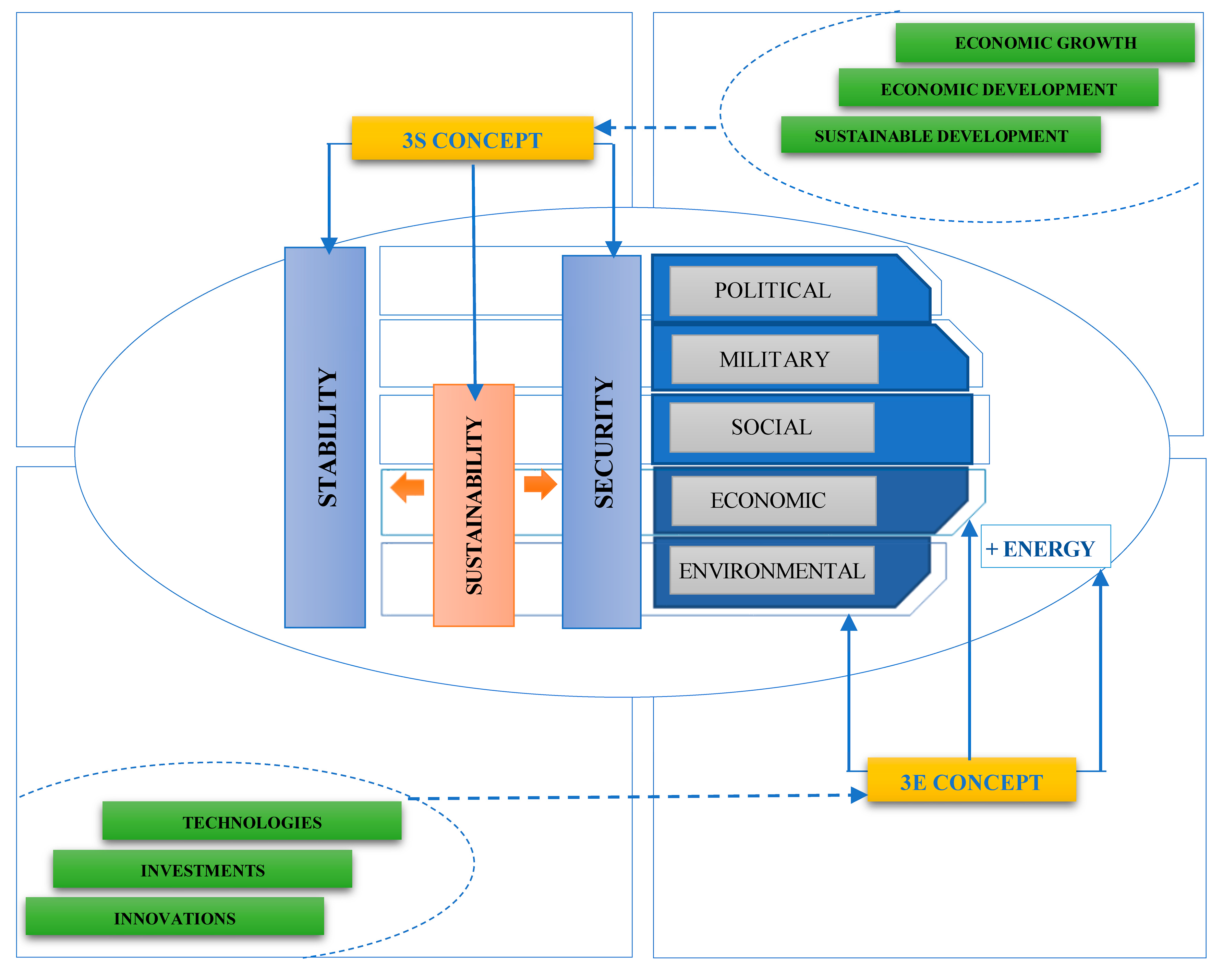
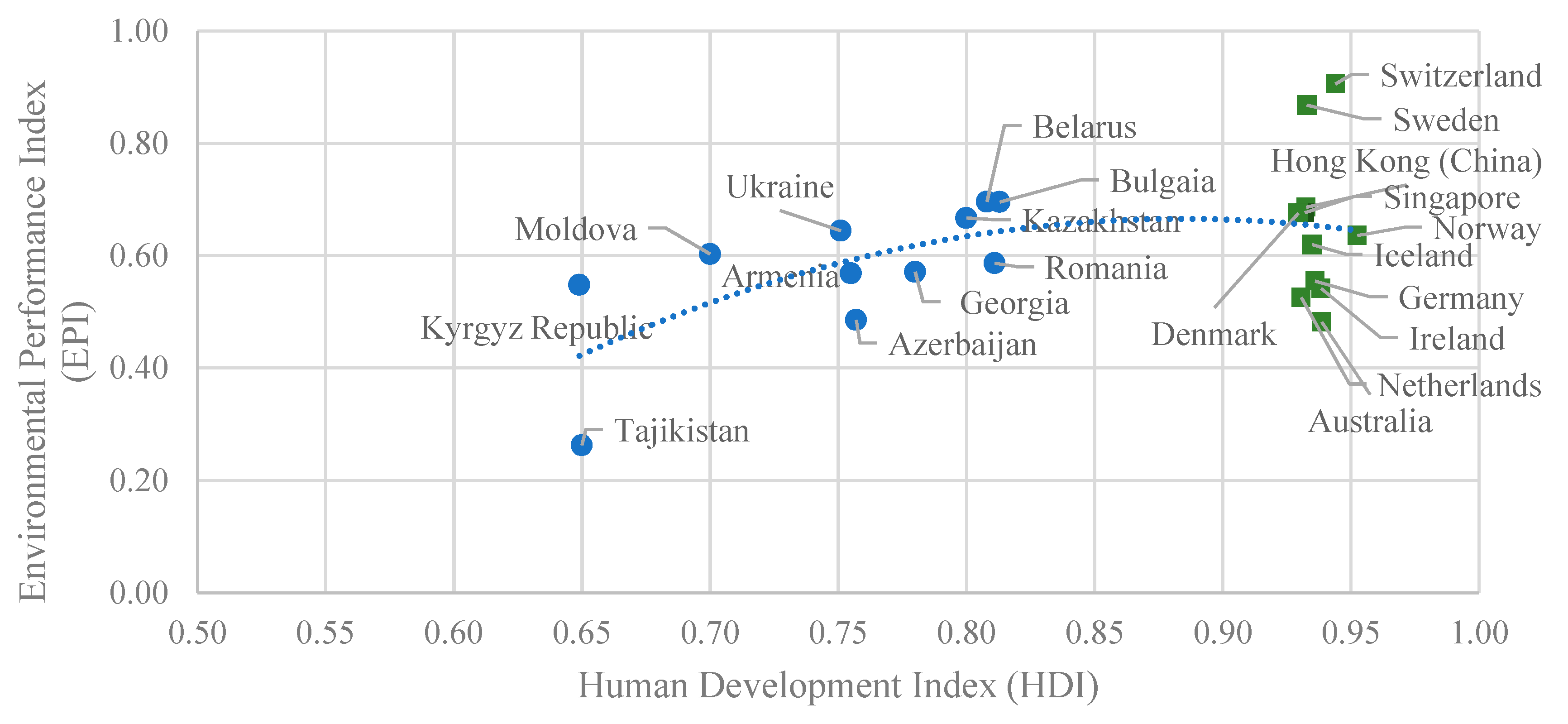
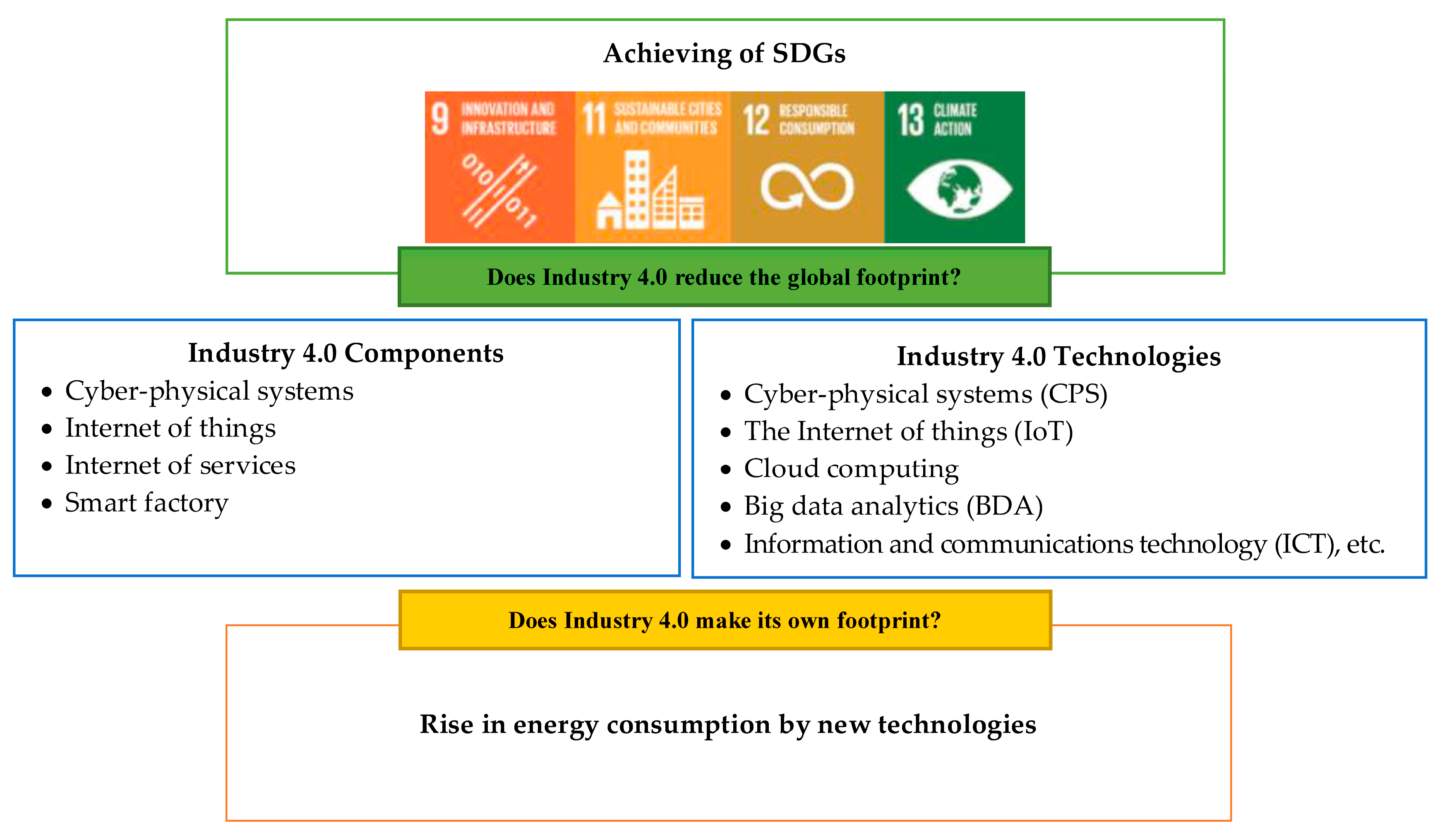
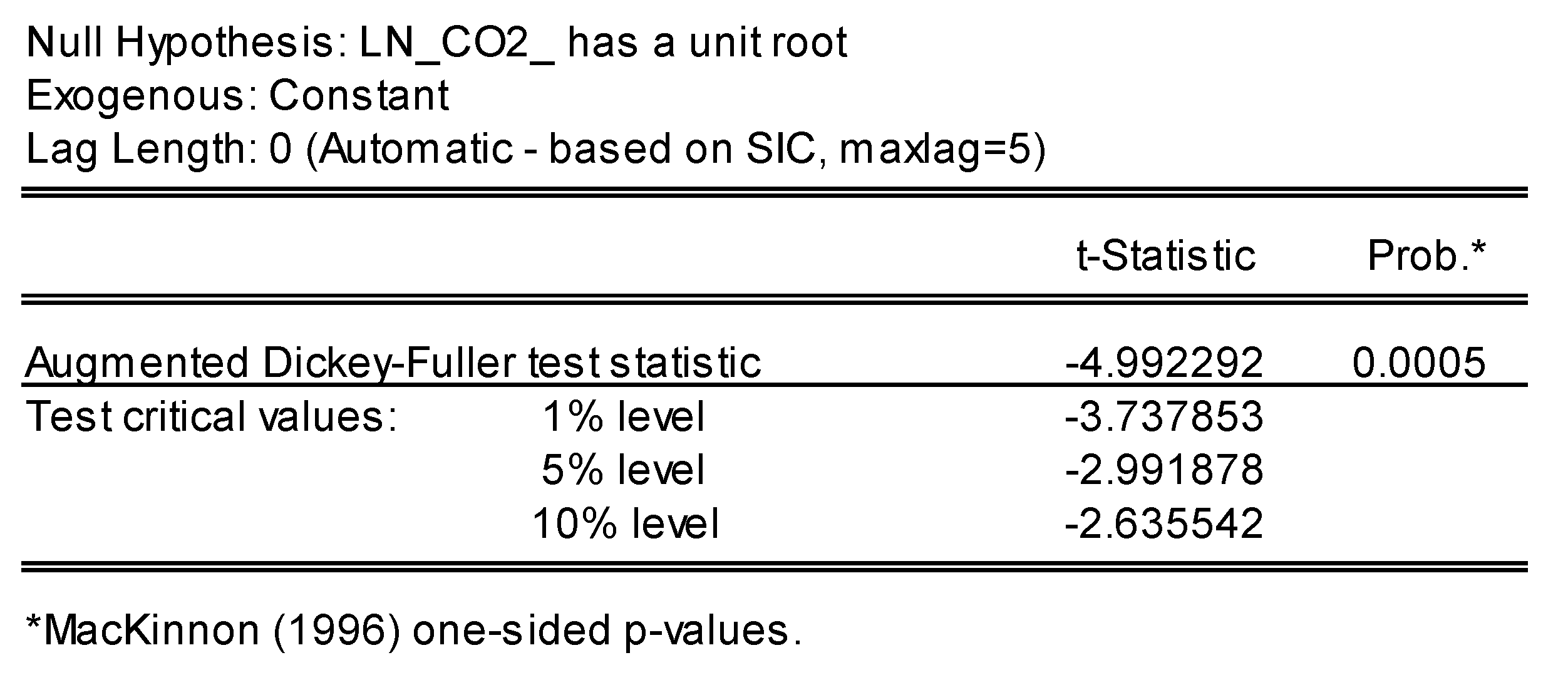
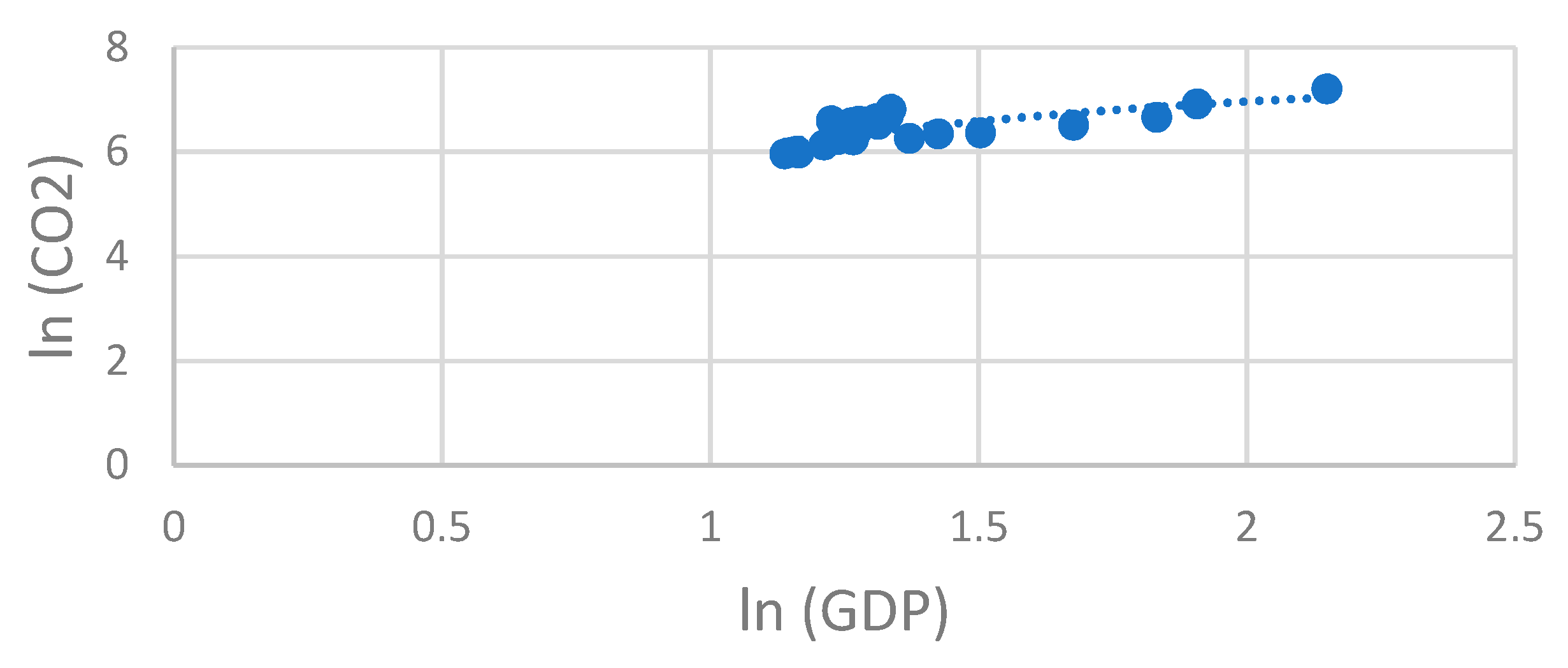
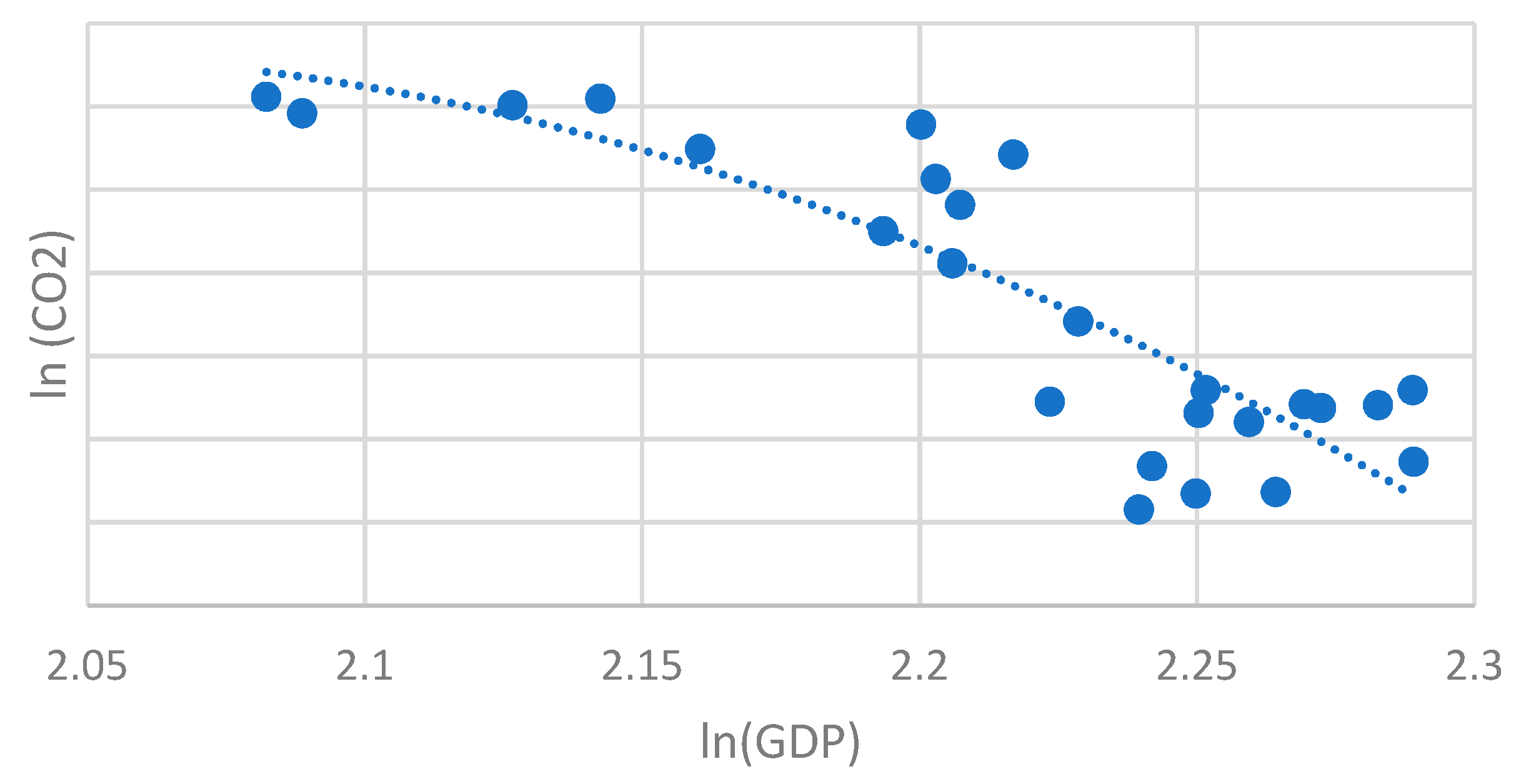
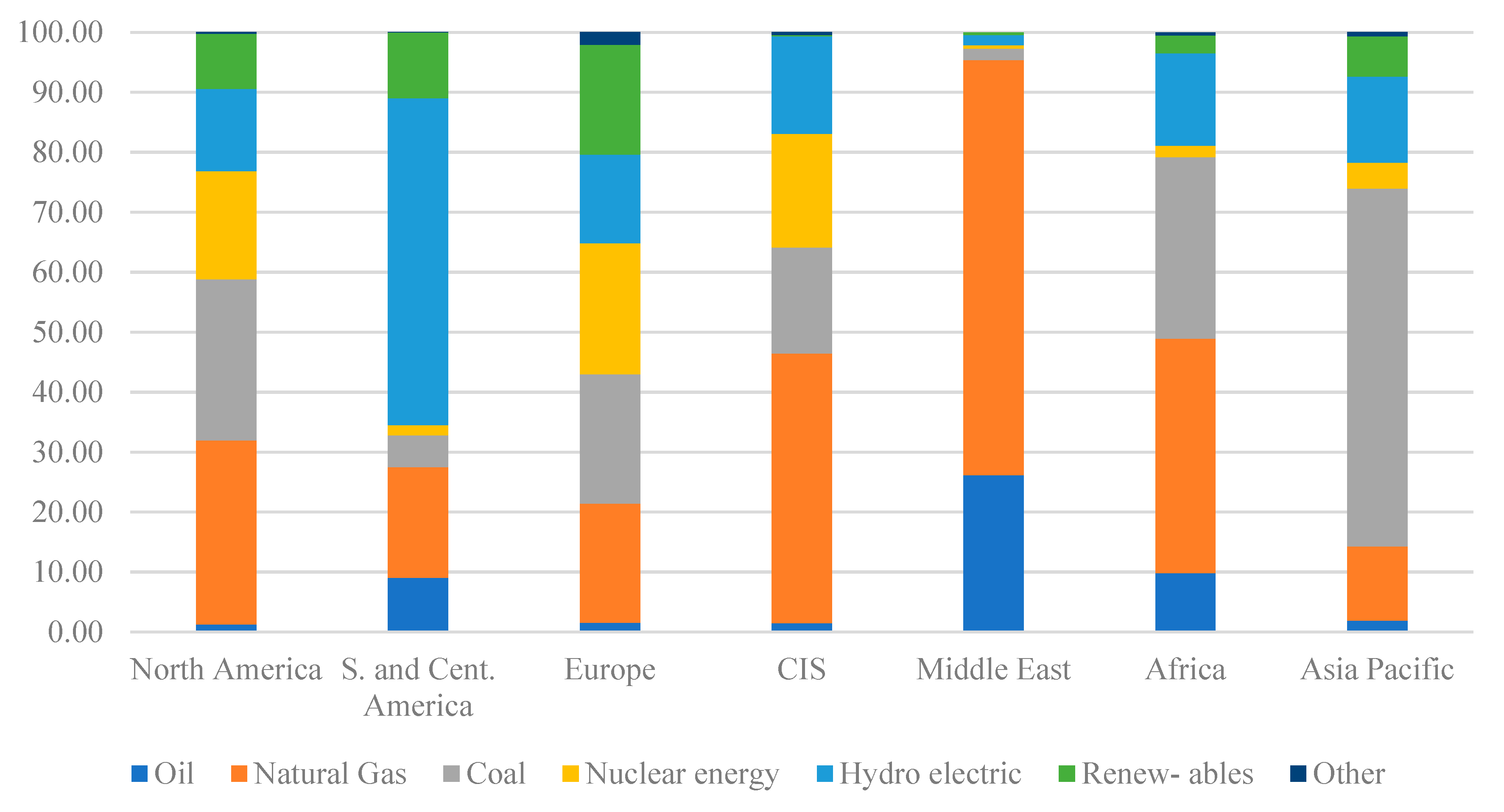
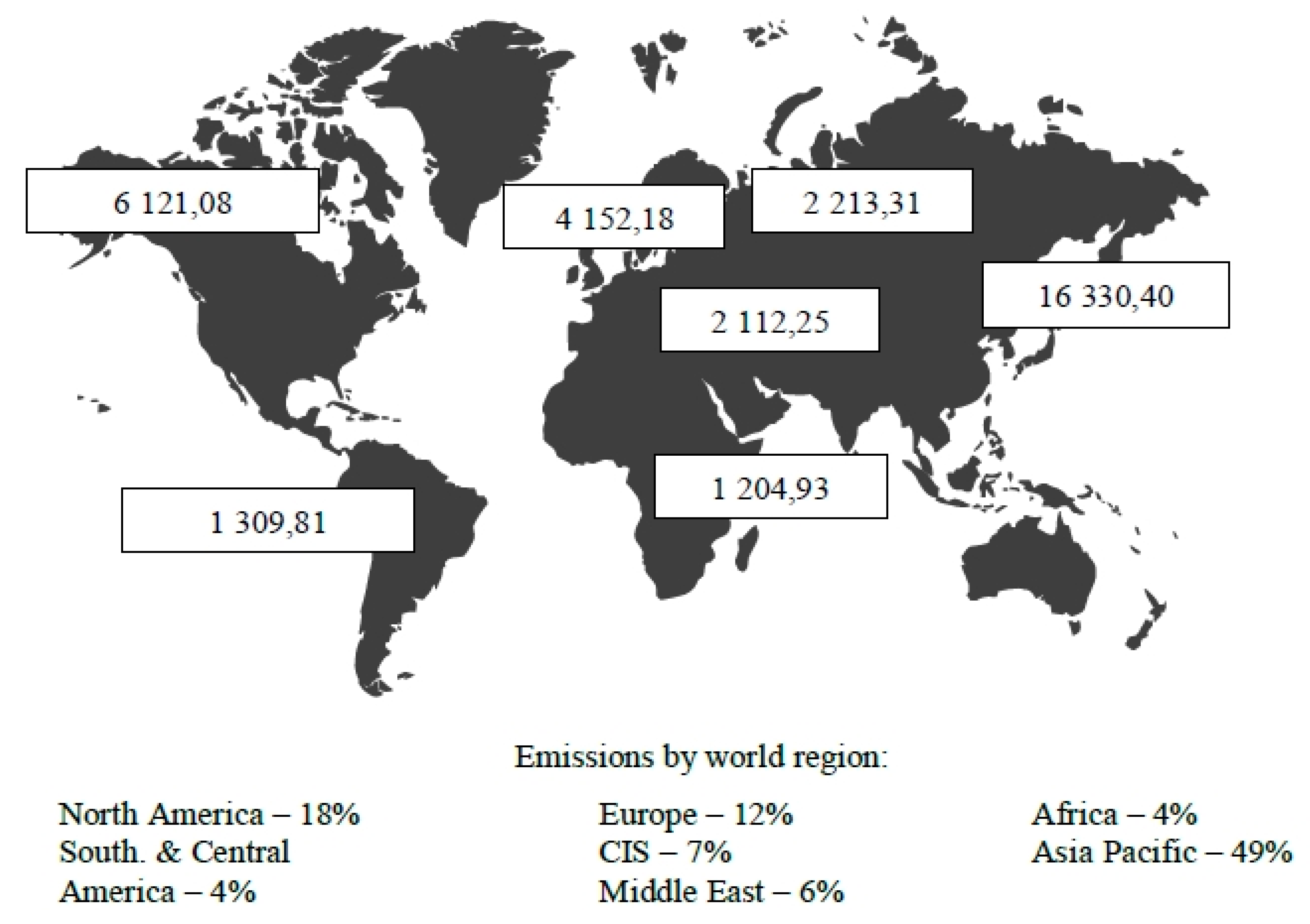
| Dependent Variable: Log(CO2) | |||
|---|---|---|---|
| Sample: 1990–2014 | |||
| Included observations: 11 | |||
| Variable | Coefficient | t-Statistic | Std. Error |
| Constant | −9.16 * | −3.62 | 2.53 |
| log(GDP) | 2.27 * | 3.99 | 0.57 |
| log2(GDP) | −0.12 * | −3.49 | 0.04 |
| log(FDI) | −0.03 | −1.56 | 0.02 |
| log(Energy) | 0.71 * | 4.19 | 0.17 |
| log(Trade) | −0.16 ** | −1.91 | 0.08 |
| R-squared | 0.96 | ||
| Adjusted R-squared | 0.95 | ||
| Sum of squared residuals (SSR) | 1.13 | ||
| Residual sum of squares (RSS) | 0.05 | ||
| F-statistic | 92.94 | ||
| Prob(F-statistic) | 0.00 | ||
| Country | Average CO2 (Metric tons per Capita) | Average Real GDP per Capita (Current US$) | Income Elasticity of CO2 |
|---|---|---|---|
| Armenia | 1.37 | 1659.24 | 0.091 |
| Azerbaijan | 4.18 | 2455.27 | 0.441 |
| Bulgaria | 6.33 | 3692.71 | 0.517 |
| Belarus | 6.28 | 3324.98 | 0.527 |
| Georgia | 1.48 | 1754.22 | 0.102 |
| Kazakhstan | 11.95 | 4589.37 | 0.690 |
| Kyrgyz Republic | 1.31 | 612.18 | 0.085 |
| Moldova | 1.89 | 1055.71 | 0.170 |
| Romania | 4.75 | 4403.65 | 0.422 |
| Tajikistan | 0.48 | 438.16 | −0.323 |
| Ukraine | 7.21 | 1875.36 | 0.604 |
| Country | 1990 | 2010 | 2011 | 2012 | 2013 | 2014 | 2015 |
|---|---|---|---|---|---|---|---|
| Armenia | 24.37 | 5.39 | 5.63 | 5.75 | 5.43 | 5.35 | 5.38 |
| Azerbaijan | 15.57 | 3.36 | 3.64 | 3.88 | 3.72 | 3.76 | 3.73 |
| Bulgaria | 14.60 | 6.63 | 7.02 | 6.69 | 6.09 | 6.36 | 6.38 |
| Belarus | 23.13 | 7.73 | 7.81 | 7.98 | 7.06 | 6.83 | 6.47 |
| Kazakhstan | 13.83 | 8.47 | 8.84 | 8.07 | 8.42 | 7.87 | 7.92 |
| Kyrgyz Republic | 20.54 | 7.58 | 8.61 | 10.76 | 9.26 | 9.21 | 8.64 |
| Moldova | 17.40 | 10.50 | 9.71 | 9.68 | 7.95 | 8.16 | 8.39 |
| Romania | 10.05 | 4.17 | 4.22 | 4.09 | 3.61 | 3.48 | 3.52 |
| Russian Federation | 12.03 | 8.73 | 8.78 | 8.70 | 8.46 | 8.35 | 8.41 |
| Tajikistan | 11.54 | 5.66 | 5.29 | 5.29 | 5.46 | 5.06 | 5.01 |
| Ukraine | 19.38 | 15.41 | 14.00 | 13.52 | 12.82 | 12.49 | 11.79 |
| European Union | 5.63 | 4.21 | 3.98 | 3.96 | 3.91 | 3.70 | 3.66 |
| Country | 1990 | 2000 | 2010 | 2011 | 2012 | 2013 | 2014 | 2015 | 2016 |
|---|---|---|---|---|---|---|---|---|---|
| Ukraine | 1.34 | 1.37 | 0.86 | 0.85 | 0.83 | 0.80 | 0.73 | 0.65 | 0.67 |
| Poland | 1.17 | 0.65 | 0.48 | 0.45 | 0.43 | 0.43 | 0.39 | 0.37 | 0.36 |
| Germany | 0.44 | 0.32 | 0.27 | 0.25 | 0.25 | 0.26 | 0.24 | 0.24 | 0.24 |
| World | 0.50 | 0.42 | 0.38 | 0.37 | 0.36 | 0.36 | 0.35 | 0.34 | 0.32 |
| Region | Correlation Coefficients, Energy vs. ICT Indicators | ||
|---|---|---|---|
| ICT1 | ICT2 | ICT3 | |
| Total Africa | −0.86 | 0.97 | 0.99 |
| Total Middle East | −0.79 | 0.92 | 0.99 |
| Total Asia Pacific | −0.90 | 0.98 | 1.00 |
| Total CIS | 0.16 | 0.24 | 0.32 |
| Total Europe | 0.67 | −0.67 | −0.81 |
| Total Americas | −0.77 | 0.61 | 0.73 |
© 2019 by the author. Licensee MDPI, Basel, Switzerland. This article is an open access article distributed under the terms and conditions of the Creative Commons Attribution (CC BY) license (http://creativecommons.org/licenses/by/4.0/).
Share and Cite
Koilo, V. Evidence of the Environmental Kuznets Curve: Unleashing the Opportunity of Industry 4.0 in Emerging Economies. J. Risk Financial Manag. 2019, 12, 122. https://doi.org/10.3390/jrfm12030122
Koilo V. Evidence of the Environmental Kuznets Curve: Unleashing the Opportunity of Industry 4.0 in Emerging Economies. Journal of Risk and Financial Management. 2019; 12(3):122. https://doi.org/10.3390/jrfm12030122
Chicago/Turabian StyleKoilo, Viktoriia. 2019. "Evidence of the Environmental Kuznets Curve: Unleashing the Opportunity of Industry 4.0 in Emerging Economies" Journal of Risk and Financial Management 12, no. 3: 122. https://doi.org/10.3390/jrfm12030122
APA StyleKoilo, V. (2019). Evidence of the Environmental Kuznets Curve: Unleashing the Opportunity of Industry 4.0 in Emerging Economies. Journal of Risk and Financial Management, 12(3), 122. https://doi.org/10.3390/jrfm12030122





